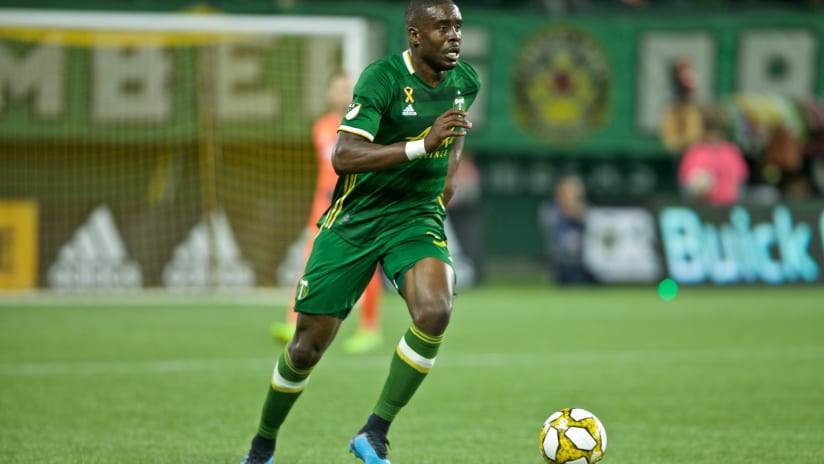BEAVERTON, Ore. – The calendar read October 2, 2019, but beneath the questions Portland Timbers players and coaches faced about their upcoming opponent, minds drifted back to April 6, a moment defender Larrys Mabiala described as “the bottom” of his team’s season.
“[At] the beginning of the season, not everyone was performing the way we were supposed to perform,” Mabiala remembered, having been asked about that day’s 3-0 loss. “After [San Jose], it was so tough on us.”
Goals from Shea Salinas, Danny Hoesen and Cristian Espinoza had Portland down three after 33 minutes that day at Avaya Stadium. Having gone 0-3-1 to start the season, the Timbers went to San Jose with optimism only to be rebuked. The Earthquakes, 0-4-0 before kickoff, delivered a performance that turned their season around.
“Maybe I was one of the only ones that gave them credit when no one was giving them credit, when we played the first time,” Timbers head coach Giovanni Savarese admonished. “I said, ‘be careful, this team is going to be difficult.’ Nobody believed me. Now, everybody is an expert.”
That expertise has led to a lot of discussion of San Jose’s approach, a man-marking system more familiar to a National Football League secondary than a Major League Soccer venue. Challenging their opponents to series of one-on-one matchups across the field, the Earthquakes have used fitness, clean play on the ball, and their willingness to out-work their opposition to craft a surprise playoff contender. Starting with their victory over Portland, first-year head coach Matías Almeyda’s team has gone 13-11-5, outscoring their opponents by 11 goals and moving the club to within one win of the postseason.
“It’s not easy, because you don’t really play against [the system often],” Mabiala explained, when asked about Almeyda’s scheme ahead of Sunday's Decision Day, presented by AT&T, match at Providence Park (1pm PT, TICKETS, ESPN). “When you have to play against these kinds of teams, you have to be very focused, concentrate so you can approach the game the right way.”
As Mabiala implies, it’s not a complicated process. But lack of complexity shouldn’t be confused with easy solutions. Whereas the rest of Major League Soccer and most of the soccer world use more structured systems – most of which derive their success from how, in attack, they break down their opponents or, in defense, react to the opposing tactic – San Jose’s approach is more straight-forward: find your mark; deny them the ball; and if they get possession, take it from them.
In application, the Earthquakes’ play is more complex. Their league-leading 55.7 percent average possession defies any attempt to cast them as one dimensional. The result of their approach, though, is a series of one-on-one challenges that force opponents to match San Jose’s work.
“We knew that was going to be a style that, definitely, was going to get them a better team …,” Savarese said, subtly alluding to a 2018 Earthquakes team that finished with the worst record in MLS. “Some teams will have difficulties understanding how to play against them, because it’s a different system.
“I’ve seen that system. I’ve followed Almeyda and his good jobs with other clubs, so I had a full understanding to how he plays.”
The former River Plate, Sevilla and Inter Milan midfielder had won league titles at each of his previous stops, from River Plate and Banfield in Argentina to Chivas Guadalajara in Mexico. Undoubtedly, and like Savarese, other managers around MLS had a good idea what he would bring north. But recognizing that philosophy and executing on the field are two different things, with execution requiring a balance between maintaining your game and recognizing San Jose’s virtues.
“That once you start focusing too much on [San Jose’s scheme], you lose track of who you are,” Savarese said. “I think that is a very important point. We need to be who we are. We need to think of ourselves first, the good things that we can do, and then, at the end, analyze how we can hurt this team.”
That’s where memories of April’s failures may help most. Since August 10, when San Jose’s schedule sent them into more rematches against the Western Conference, Almeyda’s team has gone 2-8-0, with their only wins coming at home against the West’s last-place team (Vancouver) and the 11th-place team in the East (Orlando). If part of the theory of Almeyda’s man-marking approach – as well as its summer success – was teams’ unfamiliarity, the supporting evidence is starting to pile up.
Perhaps his players are tired; or, for some other reason, Almeyda’s group is just not playing as well. It’s also possible MLS has gotten used to what the new San Jose Earthquakes will offer.
“Honestly, it was just a regular season game,” Portland attacker Jeremy Ebobisse said, when asked about April’s result. “This game presents new challenges. And new stakes.
“We’re a completely different team than we were, back then: more united; more together, as far as tactically, as well. What happened there, it’s going to be our job to prove that was just a fluke.”
The Timbers have no choice. Though the team could still reach a third-straight postseason with a loss (and some help), the only way to ensure their playoff ticket’s punched is by redeeming April 6. And in Savarese’s view, his team knows exactly what to do if they’re to reach the postseason.
“To be quite honest with you, we have our ideas very clear in what we want to do,” he told the media on Wednesday. “That’s what we are practicing, and trying to make sure that we stick to the plan.”












